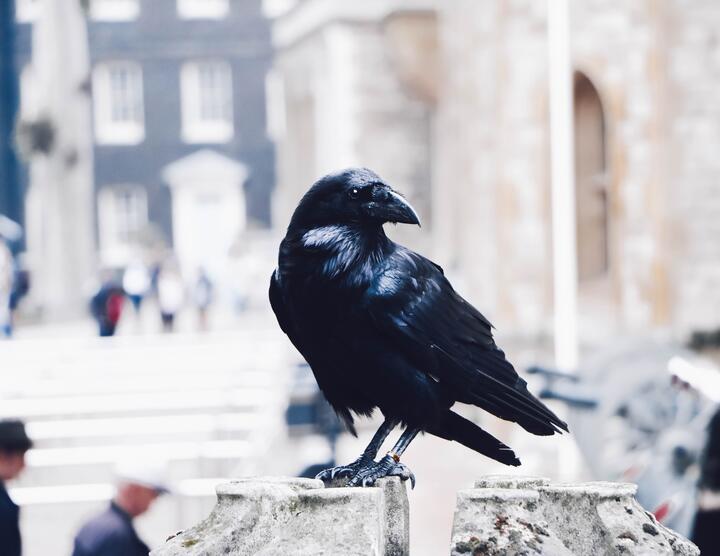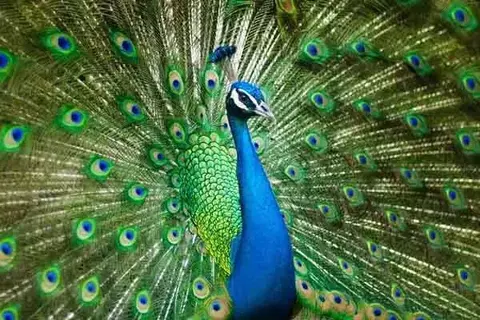50 Interesting And Surprising Facts About Ravens
Charlotte GreenRavens are probably the most familiar bird after sparrows of pigeons for city dwellers. These blackbirds are especially noticeable in winter, in the background of snow. We present to you 50 interesting facts about ravens.
Amazing raven facts
 Photo by Kasturi Roy on Unsplash
Photo by Kasturi Roy on Unsplash1.Ravens are species of the genus Corvus. This name unites several bird species. They are similar, and many representatives of the species are confused with each other. Ravens include Crow, Rook, Pebble, and Raven.
2.Most people consider a crow and a raven to be the same bird. But they are of different species, not males and females from the same family. The difference is not striking, but rather noticeable: a raven is a larger individual, 10-15 cm longer than a black or gray crow, and the raven has a darker color.
3.Ravens are some of the smartest birds. When it comes to exploration, these birds, according to research scientists, react better than dolphins and chimpanzees.
4.Research carried out by American scientists has shown that ravens can easily solve the logical problems of a 5-year-old child.
5.Ravens live in every corner of the world. They can easily get along in both snow and desert conditions, both in deserts and forests.
6.Ravens can be friends. If a bird is in trouble, its friends will certainly come to the rescue. They will take care of the wounded friend and bring him food until the bird is fully recovered.
7.Ravens can remember and transmit information through generations. Mostly this is the case with resentment. There is confirmation that after a few years, and after overcoming hundreds of kilometers, a flock of crows came to the offender.
8.The ability to “read gestures” made it possible for ravens to imitate sounds from nature and animals. Thus, by depicting the cry of a fox or wolf, birds can deter other predators from preying.
9.Ravens remember perfectly well the places and situations that ended up being victims on their part. They avoid these places, even change their migration routes.
10.Ravens can calculate ahead of the actions of others and adjust their own accordingly. Many people are familiar with the habit of ravens to stock. This, of course, can do many other animals. But the ravens went much further in the art of measures and countermeasures. If one raven is trying to hide something, there are several interested observers. Then the first one, hiding, pretends to have just buried something, and at this moment hides his goodness on his chest between feathers. And quickly flies to another place. Observers quite quickly bite such tricks, they instantly lose interest in the place of “burial” and follow the real “treasure”. These races, competitions in secrecy can continue for a very long time and reach an unprecedented scale.
11.Ravens are faithful spouses. As soon as the chick can take care of himself, he must leave the parental nest. The raven joins the “single ravens” and the bird will live in this flock of relatives until it has the other half. From this moment on, the ravens leave the flock to live with their partner, keeping him faithful even after the death of their spouse.
12.There is another oddity in the birds’ behavior when a raven dies, its comrades are holding a memorial service. Having found the body of a dead bird, they announce the space for fifteen minutes with heartbreaking screams, as if on command the birds calm down, sit on branches, and mournfully remain silent. Modern researchers can’t explain this phenomenon.
13.According to the myths of Tibet and Greece, ravens are messengers of the gods.
14.In China, it was considered that ravens cause bad weather, at the will of gods to warn people about impending danger.
15.Ravens use twigs to get bugs and larvae from under the tree bark, thus protecting their beak from damage. Parents don’t teach them how to make such specialized devices for their chicks. This skill is passed on from these birds on a genetic level.
16.City ravens love games, they are not afraid of dogs and cats.
17.If the raven finds dry bread, it won’t eat rough food at once. The bird will look for a source to soften its prey. Any puddle will do, the bird will wait for the crust to soften.
18.Scientists once tested the ravens for intelligence. The participants were offered two vessels (one containing water and the other filling). There were large and small stones lying there. The ravens easily completed the task. The birds accurately selected the right size stones and threw them into a water container. Gradually the water rose to the right level that the birds could quench their thirst. And the crows did not pay attention to the sand vessel. Birds somehow distinguished the stones that would go to the bottom from useless light objects.
19.Captive ravens can learn to speak better than some parrots.
20.In the wild, ravens often mimic wolves and foxes. By emulating their cry, ravens often manage to scare them away from their prey and eat their leftovers.
21.Ravens use mirrors to find hidden delicacies. And they easily find the “feedback” between the mirror image and reality.
22.In winter, people often observed birds riding from the ice mountain and church domes.
23.The ravens have learned how to use the human environment very well. They know that the best way to break nuts is to throw them on hard asphalt. What’s more, they don’t just throw nuts on the ground, they throw them under the wheels of cars. And they calculate the speed of the vehicle. And then they know that you can pick up a broken nut only at a red traffic light when the cars are standing.
24.Ravens can pick up and emulate the sounds of car engines, toilet flushes, and screams from animals.
25.The fact that ravens are very sensible is also confirmed by the fact that when there is an imminent danger to their chicks, ravens can throw stones from their nests directly at people.
26.The ravens also know clearly that food can be taken out of garbage cans. But usually, the bins are tightly closed, but their contents are accessible after the workers arrive and are overloaded in the garbage truck. So the ravens memorize the schedules and routes of such equipment perfectly and use this knowledge.
27.Ravens can communicate without being accompanied by sound signals. According to research in Austria, crows can show many gestures with their beak.
28.Ravens can read information transmitted by beak swings. Also, a separate pack may have its sign language that only a small community can understand.
29.It turns out that our winged friends recognize numbers, i.e. they can count and can solve problems. For example, if you put two bowls of food in front of a crow, and add at least 2-3 more grains to one, the bird will correctly choose the bowl where there are more grains. It is noteworthy that no one can perform this action correctly.
30.There was also such an experiment with crows. The bird was placed in a box with a small box containing a large piece of delicious meat. Next to it, there was a second drawer with a long stick and a small stick. It was impossible to remove meat from the box with a small stick. Raven did not think long about the problem, she took out with a small stick big, and then got her meat!
31.The ravens, having found the anthill, start to roll around and pick feathers. They do this so that more ants can get under the feather cover. This behavior is not quite clear, however, one theory says that the raven does this to calm the skin after molting and sprouting new feathers.
32.In the forest, ravens often play with predators, and people watch birds chase a fox, wolf, or otter.
33.And the ravens also like team games. One of the birds, holding some small object in its beak, it could be a stick or a rock. The raven takes off high and passes the pass to another player. This continues until the toy is on the ground.
34.Often ravens were looked upon by Celtic goddesses of war during battles.
35.In some Indian tribes, ravens were worshipped as separate deities.
36.Ravens are unpretentious in their food. They eat everything: fish, meat, the fruit of trees, scavengers, and even garbage.
37.Another feature of nutrition has been noticed. Young people prefer to eat in flocks, knowing that together it is easier to scare away or take away their prey from other animals. More mature individuals prefer to eat alone or with their own family.
38.According to researchers, ravens have a developed analytical flair, and the ability to receive information is as good as the primates.
39.The ravens’ playfulness has been noticed by Native Americans. Ravens can ride on snowy hills for entertainment only.
40.Ravens can also “attack” other birds. They can dismantle other people’s nests, steal a few or two laid eggs.
41.Like any living creature spending time in a pack, the ravens are forced to use speech. The way they communicate is through their sonic imitations. For the human ear, the raven’s tongue sounds like a variation of the sound of “kar”. However, for these birds sound has different meanings: indistinguishable tones to humans determine the signs of danger, anxiety, compassion, joy, and other emotional shades and information transmitted.
42.The following experiment was carried out, which included, besides Adelie and Betty’s ravens, a small basket hidden in a larger vessel and a couple of delays. At the same time for Adelie and Betty prepared 2 delays, one of which was with a hook, and the other is flat. Adele picked the bent one out of the 2 pieces of wire at once. Betty thought about her straight piece and gently bent it too and pulled out her basket. It’s worth noting the interesting fact that this was the first time the crow’s wire had been seen.
43.The French believed that ravens were the reincarnated souls of wicked monks and nuns.
44.In Germany, ravens were thought to have a demonic origin.
45.In Sweden, the night rattle of ravens was associated with the curse of an unconscious soul.
46.In the case of approaching danger, ravens can drop a nut, stone, or another object on a person or animal, thereby ensuring the safety of themselves and their offspring.
47.In Denmark, it was believed that ravens cast out evil spirits, and if you look at them at that moment, you can turn into a crow.
48.The ravens are extremely playful. It is not uncommon to see crows playing with other animals. In the game, the crow can use sticks, lumps, balls, and other items that will find nearby.
49.Ravens living in cities have learned to easily get food for themselves, sometimes quite tricky methods to deceive people.
50.The raven’s life cycle is between 17 and 40 years. Everything depends on the conditions of existence and diet. Ironically, captive birds have a longer life expectancy. Moreover, they get used to man, and if he cares for the bird properly, he will guard it in gratitude.
Did you like interesting facts about ravens? Share it with your friends.
Facts About Ravens
 Photo by Meg Jerrard on Unsplash
Photo by Meg Jerrard on UnsplashThe common raven is a large, black passerine bird that is widely distributed in the Northern Hemisphere. It is also the most widely distributed corvid in the world, which means that it is an extremely common species. This fact sheet will give you the basics on the raven, including some interesting facts. Read on to learn more about this fascinating bird. Listed below are some corvid facts. Once you know what this bird looks like, you can enjoy its beautiful song and watch for it in the wild.
This amazing bird is one of the most unique birds in the world and lives in many parts of the world. Its coloration is due to a rare pigment condition known as leucism, which results in blue eyes and fair feathers. These birds are very social and live in large groups, called “unkindnesses.” They would use their collective intelligence to find prey, which was often a rat or mouse. This bird has a wide vocabulary and uses 20 different sounds to communicate with other ravens. Their calls can warn other birds of impending danger, or help them find food.
In addition to these corvid facts, ravens are highly social animals. They live in large groups of several hundred birds, or “unkindnesses,” which could reach more than 500 birds. During this time, the hives of a large group would work together to locate food. Their vocalizations are incredibly complex, with over 20 different sounds. Their vocalizations are also used to warn other ravens of danger or to find food sources.
Another interesting fact about the common raven is that it mimics human speech. It can imitate human voices and objects, including the sounds of car engines and toilet flushes. It also can mimic the sounds of wolves, foxes, and even humans. These traits make the common raven a valuable member of the crow family. There are other fascinating facts about the common raven, including how it can make noises similar to those of human beings.
The common raven is a social bird. They live in large groups called “unkindnesses,” and a large group of ravens can have over 500 members. The birds can communicate by using a variety of sounds and use this collective intelligence to find food. Besides being very social, the common and the black-headed raven can remember people and have a surprisingly long memory. They can also learn new things.
The common raven has been living with humans for thousands of years. Although it has been considered a pest in some places, it has become so common in some regions that people have viewed it as a nuisance. A common raven is an omnivorous bird, consuming carrion, insects, and grains. It also feeds on small animals, insects, and human food waste. There are a variety of myths and legends about the raven.
- BirdsAmazing Facts About A Peacock

- DogsHeal Your Allergic Dog The Natural WayBy Lucas Torres

- WildlifeInteresting Facts About LemursBy Khai Dove

- WildlifeAmazing Facts About A StarfishBy Nolan Foster

- RodentsWhat Do Hedgehogs Eat In The Wild And At Home?By Camilo Walker

- InsectsLadybug’S Nest And Other Ladybug FactsBy Lucas Torres

- DogsRules For Feeding Your PuppyBy Karla Miller

- DogsPreparing For Puppy: Must Have Tips For Your Puppy’S First WeekBy Camilo Walker

- BirdsWhich Hawk Is The Largest?By Khai Dove

- Wildlife7 Interesting Facts About LionsBy Noah Young
